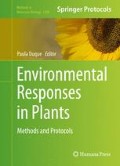Abstract
Posttranscriptional control makes an important contribution to circadian regulation of gene expression. In higher plants, alternative splicing is particularly prevalent upon abiotic and biotic stress and in the circadian system. Here we describe in detail a high-resolution reverse transcription-PCR based panel (HR RT-PCR) to monitor alternative splicing events. The use of the panel allows the quantification of changes in the proportion of splice isoforms between different samples, e.g., different time points, different tissues, genotypes, ecotypes, or treatments.
Access this chapter
Tax calculation will be finalised at checkout
Purchases are for personal use only
References
Reddy ASN, Marquez Y, Kalyna M et al (2013) Complexity of the alternative splicing landscape in plants. Plant Cell 25:3657–3683
Staiger D, Brown JWS (2013) Alternative splicing at the intersection of biological timing, development, and stress responses. Plant Cell 25:3640–3656
Streitner C, Hennig L, Korneli C et al (2010) Global transcript profiling of transgenic plants constitutively overexpressing the RNA-binding protein AtGRP7. BMC Plant Biol 10:221
Hennig L, Menges M, Murray JA et al (2003) Arabidopsis transcript profiling on Affymetrix GeneChip arrays. Plant Mol Biol 53:457–465
Hazen SP, Naef F, Quisel T et al (2009) Exploring the transcriptional landscape of plant circadian rhythms using genome tiling arrays. Genome Biol. 10: R17.
Simpson CG, Fuller J, Maronova M et al (2008) Monitoring changes in alternative precursor messenger RNA splicing in multiple gene transcripts. Plant J 53:1035–1048
Raczynska KD, Simpson CG, Ciesiolka A et al (2010) Involvement of the nuclear cap-binding protein complex in alternative splicing in Arabidopsis thaliana. Nucleic Acids Res 38:265–278
Streitner C, Köster T, Simpson CG et al (2012) An hnRNP-like RNA-binding protein affects alternative splicing by in vivo interaction with target transcripts in Arabidopsis thaliana. Nucleic Acids Res 40:11240–11255
Streitner C, Simpson CG, Shaw P et al (2013) Small changes in ambient temperature affect alternative splicing in Arabidopsis thaliana. Plant Signal Behav 8:e24638
Filichkin SA, Priest HD, Givan SA et al (2010) Genome-wide mapping of alternative splicing in Arabidopsis thaliana. Genome Res 20:45–58
Marquez Y, Brown JWS, Simpson CG et al (2012) Transcriptome survey reveals increased complexity of the alternative splicing landscape in Arabidopsis. Genome Res 22:1184–1195
Staiger D, Shin J, Johansson M et al (2013) The circadian clock goes genomic. Genome Biol 14:208
Hsu PY, Harmer SL (2014) Wheels within wheels: the plant circadian system. Trends Plant Sci 19(4):240–9
James AB, Syed NH, Bordage S et al (2012) Alternative splicing mediates responses of the Arabidopsis circadian clock to temperature changes. Plant Cell 24:961–981
James A, Syed N, Brown J et al (2012) Thermoplasticity in the plant circadian clock: How plants tell the time-perature. Plant Signal Behav 7:1219–1223
Sanchez SE, Petrillo E, Beckwith EJ et al (2010) A methyl transferase links the circadian clock to the regulation of alternative splicing. Nature 468:112–116
Jones MA, Williams BA, McNicol J et al (2012) Mutation of Arabidopsis SPLICEOSOMAL TIMEKEEPER LOCUS1 causes circadian clock defects. Plant Cell 24:4907–4916
Staiger D, Heintzen C (1999) The circadian system of Arabidopsis thaliana: forward and reverse genetic approaches. Chronobiol Int 16:1–16
Schmal C, Reimann P, Staiger D (2013) A circadian clock-regulated toggle switch explains AtGRP7 and AtGRP8 oscillations in Arabidopsis thaliana. PLoS Comput Biol 9:e1002986
Werneke JM, Chatfield JM, Ogren WL (1989) Alternative mRNA splicing generates the two ribulosebisphosphate carboxylase/oxygenase activase peptides in spinach and Arabidopsis. Plant Cell 1:815–825
Chomczynski P, Sacchi N (1987) Single-step method of RNA isolation by acid guanidinium thiocyanate-phenol-chloroform extraction. Anal Biochem 162:156–159
Kim SH, Koroleva OA, Lewandowska D et al (2009) Aberrant mRNA transcripts and the nonsense-mediated decay proteins UPF2 and UPF3 are enriched in the nucleolus. Plant Cell 21:2045–2057
Acknowledgements
Work in our laboratories is supported by grants from the Biotechnology and Biological Sciences Research Council (BB/G024979/1, European Research Area network Plant Genomics [Plant Alternative Splicing and Abiotic Stress]) and the Scottish Government Rural and Environment Science and Analytical Services division (to J.W.S.B. and C.S.) and the DFG (STA 653 and SPP1530) (to D.S.).
Author information
Authors and Affiliations
Corresponding author
Editor information
Editors and Affiliations
Rights and permissions
Copyright information
© 2016 Springer Science+Business Media New York
About this protocol
Cite this protocol
Simpson, C.G. et al. (2016). Monitoring Alternative Splicing Changes in Arabidopsis Circadian Clock Genes. In: Duque, P. (eds) Environmental Responses in Plants. Methods in Molecular Biology, vol 1398. Humana Press, New York, NY. https://doi.org/10.1007/978-1-4939-3356-3_11
Download citation
DOI: https://doi.org/10.1007/978-1-4939-3356-3_11
Published:
Publisher Name: Humana Press, New York, NY
Print ISBN: 978-1-4939-3354-9
Online ISBN: 978-1-4939-3356-3
eBook Packages: Springer Protocols

